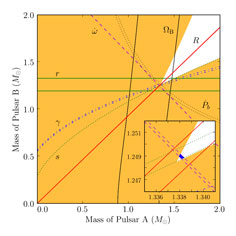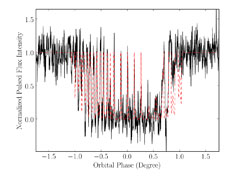Rene Breton (McGill University)

Mass-mass diagram illustrating the present tests constraining general relativity in the double pulsar PSR J0737-3039A/B. Because observations are consistent with general relativity, all lines intersect at common values of masses. Shaded orange regions are unphysical solutions because sin i ≤ 1, where i is the orbital inclination. The mass ratio, R, and five post-Keplerian parameters (s and r, Shapiro delay shape and range; ω., periastron advance; Pb., orbital period decay due to the emission of gravitational waves; and γ, gravitational redshift and time dilation) were reported by Kramer et al. (2006). The spin precession rate of pulsar B, ΩB, yields a new constraint on the mass-mass diagram.
 Zoom
Zoom

Average eclipse profile of pulsar A consisting of eight eclipses observed at 820 MHz over a 5-day period around 11 April 2007 (black line), and model eclipse profile (red dashed line). The resolution of each data point is ~91 ms while 1° in orbital phase corresponds to 24.5 s.
 Zoom
Zoom
In forty years of radio pulsar astrophysics, binary pulsar research has built up an impressive pedigree of observational tests of gravitational theories, starring Einstein's general relativity upfront as the one theory yet to be defeated.
Binary pulsar tests of gravity yield their incredible success from two fundamental properties. First, radio pulsars emit periodic pulsations that can be timed to a precision that rivals, in some cases, the best atomic clocks. When found in binary systems, these frequency standards are ideal tools for studying orbital dynamics since the orbital Doppler shift is imprinted in the time of arrival of their pulses. Second, pulsars are extremely small and dense, and hence they dynamically behave like test-particles. Besides black holes, which represent obvious observational challenges, pulsar-neutron star binaries are the 'best' relativistic stellar systems that can be found in nature.
Traditional tests of general relativity involving binary pulsars are based on observations of their pulse arrival times. Relativistic effects give rise to several observable timing features that cannot be explained using Newtonian physics. Such measurements have been conducted in about a dozen binary pulsars, including the canonical PSR B1913+16, the first relativistic binary pulsar known (The 1993 Nobel Prize in Physics was awarded to its discoverers, Hulse and Taylor).
In early 2004, thirty years after PSR B1913+16 was found, the field of pulsar astronomy was rejuvenated with the discovery by Burgay et al. and Lyne et al. of the first and still only known pulsar-pulsar system. PSR J0737-3039A/B consists of a 23-ms pulsar orbiting a 2.8-s pulsar companion in a 2.4-h orbit, which makes it the most relativistic pulsar binary. In just two years of timing with the 100-meter NRAO Green Bank Telescope (GBT), the double pulsar permitted four independent tests of general relativity and other theories of gravity from the theory-independent measurement of the mass ratio of the system (via the timing of both pulsars) and the observation of five relativistic timing parameters (Kramer et al. 2006). One of these tests, involving the Shapiro shape parameter, already yielded the best constraint of general relativity in the strong gravitational field with 0.05% relative uncertainty.
The cosmic coincidence does not stop there: the double pulsar is seen almost edge-on and 30-s eclipses of the 23-ms pulsar (A) by its companion (B) are visible every orbit. These eclipses of pulsar A were rapidly recognized to be asymmetrical (Kaspi et al. 2004) and high time resolution analysis (McLaughlin et al. 2004) revealed narrow modulation features in the pulsed flux intensity that are synchronized with the rotational period of pulsar B, which passes in front.
Clearly, these eclipses contrast with anything seen before and were quite puzzling until Lyutikov and Thompson proposed a model mainly based on geometry. The radio emission from pulsar A is absorbed in pulsar B's magnetosphere via synchrotron resonance with relativistic electrons trapped in the closed field lines. The key in the Lyutikov and Thompson model is that, by assuming a dipolar geometry for the magnetosphere, it is possible to reproduce periodic features seen in the eclipse profile.
The Lyutikov and Thompson model also permits the spatial orientation of pulsar B to be inferred. This offers an unprecedented tool for investigating a relativistic effect induced by spin-orbit coupling terms in the Hamiltonian of the system that cause the spin axis of pulsar B to precess around the angular momentum of the system with a period of 71 years.
We have observed the double pulsar with the GBT since 2004 as part of a regular monitoring campaign aimed at timing the pulsars and studying phenomena such as eclipses. A total of 63 eclipses have been observed at 820 MHz, using the SPIGOT backend, that have allowed us to derive a highly significant relativistic precession rate of 4.77° (+0.65°, -0.66°) per year. This result agrees with the prediction of Einstein's theory of general relativity, which gives 5.07° per year. Furthermore, the fact that both pulsars can be timed independently permits us to obtain a theory-independent constraint of the ratio between the strength of the spin-orbit coupling and the generalized gravitational constant, σΒ/G, which provides another way of comparing it with general relativity: (σΒ/Gobs) / (σΒ/GGR) = 0.94 ± 0.13.
The GBT monitoring observations therefore set a new landmark for theories of gravity. Although more accurate tests of general relativity have been obtained in the past, this new one is qualitatively important; pulsars have large self-gravitating energy, and it is not excluded, in alternative theories of gravity, that spin would interact the same way in such an extreme environment.
What's next? Certainly, the obvious step is to continue double pulsar eclipse monitoring to obtain a more stringent measurement of the relativistic spin precession rate.
Many thanks to my scientific colleagues in this work:
Victoria M. Kaspi (McGill University), Michael Kramer (Jodrell Bank Observatory), Maura A. McLaughlin (West Virginia University, NRAO), Maxim Lyutikov (Purdue University), Scott M. Ransom (NRAO), Ingrid H. Stairs (University of British Columbia), Robert D. Ferdman (University of British Columbia, Laboratoire de Physique et Chimie de l’Environnement), Fernando Camilo (Columbia University), Andrea Possenti (Istituto Nazionale di Astrofisica).
This research has been published as: "Relativistic Spin Precession in the Double Pulsar", Breton et al, Science, July 4, 2008, 321, 104.
Additional Multimedia Material
References:
Burgay, M. et al. 2003, Nature, 426, 531.
Lyne, A.G. et al. 2004, Science, 303, 1153.
Kramer, M. et al. 2006, Science, 314, 97.
Kaspi, V.M. et al. 2004, ApJ, 613, L137.
Lyutikov, M., & Thompson, C. 2005, ApJ, 634, 1223.
McLaughlin, M.A. et al. 2004, ApJ, 616, L131.

 Zoom
Zoom